
FEBRUARY/MARCH 2006
arts
news:
Press Release Press Release Press Release Press Release Press Release
MOOT IV - “reel to digital : focus on film”
The Butler Gallery in collaboration with Kilkenny County Council’s Arts Office and Darklight film festival is delighted to launch the fourth in the series of MOOT debates, discussions and seminars.
In the run up to the
MOOT IV discussion “reel to digital : focus
on film” a number of events showcasing film
shorts and feature length films by Irish and
International film makers will be screened. On February
23rd a selection of digital film shorts from
the Darklight film festival 2005 and the Young Irish Film
makers will be screened at the Arts Office No. 72 John
Street at 8 pm.
This will be followed by an informal discussion hosted by
Mike Kelly YIFM, Nicky Gogan Darklight and Dog
Media Productions.
On Tuesday February 28th ‘Leisure Center’ a film short by the Desperate Optimists and Pavee Lackeen by Perry Ogden will be screened at the Kilkenny Cineplex at 8pm. ‘Leisure Center’ has its world premiere in Dublin on February 27th.
It
is filmed in the new, only partly opened, Leisure Centre
situated on Main Street Ballymun. Shot in a day on 35mm
film with a cast of local residents and using the
cinematic device of the long take, Leisure Centre follows
a young father through the rooms and down the corridors
of the building where he works as he struggles to come to
terms with his new role as a father. It is his
partner, the mother of his child, who helps him to open
his eyes and imagine a better future for him and his
young family.
The acclaimed feature length
film Pavee Lackeen has received numerous awards
including the Rainer Werner Fassbinder Prize of
Mannheim-Heidelberg and Ecumenical Film Prize at 2005
Mannheim International Film Festival, Winner of the 10th Annual
Satyajit Ray Award, Winner at the 2005 London Film
Festival , Winner of Best Film and BSE/IFB & NIFTC
Breakthrough Talent Award – Perry Ogden at 2005
Irish Film & Television Awards and Winner of Audience
Award for Best First Feature at 2005 Galway Film Fleadh.
Pavee Lackeen presents an
unflinching portrait of a marginalised community often
living in Third World poverty in a modern, prosperous
Ireland. Filmed with a cast of mostly non-professionals,
the film uses Travelling people playing characters near
to their own, finding the core of the story in their own
life experiences.
Pavee
Lackeen tells the story of Winnie, a ten year old Irish
Traveller girl, who lives with her mother and siblings in
a dilapidated trailer on the side of the road in a
desolate industrialised area of Dublin. The film follows
Winnie through several weeks of her life as she struggles
with her identity as a young Traveller girl in
contemporary Ireland.
MOOT
is a continuous creative process providing a forum for
powerful, focused and inspirational debates and
discussion on a variety of subject matters. These events
will, potentially, transform expectations, citing shifts
in attitudes, perceptions and beliefs.
MOOT IV - Screenings
Tickets for events on February 23rd
at No. 72 John Street and on February 28th
at Kilkenny Cineplex are available from The Arts Office,
No 72 John Street. Phone: 056 7794135. Cost
€5. Places are limited tickets on sale from February
14th 2006
MOOT IV - “reel to digital : focus on film”
will take place The Brewery
Club,
Admission is free
Further details from: Niamh
Finn, Arts Office on 056 7794135 niamh.finn@kilkennycoco.ie
or Louise Allen, Butler Gallery
on 056 7761106 louise@butlergallery.com
The RTÉ Concert Orchestra and its
acclaimed Principal Conductor Laurent Wagner visit
Kilkenny with a concert of Golden Melodies from Opera
& Operetta in St Canice’s Cathedral on
Friday, 24 February at 8pm
Soprano Cara O’Sullivan
and bass-baritone John Molloy will perform music that
ranges from the beauty and passion of grand opera to the
light-hearted gaiety of the world of operetta. This
concert is for lovers of great music and great melodies,
with something for all tastes from Carousel to
‘Casta Diva’.
The acclaimed Irish soprano Cara O’Sullivan, praised on her immensely successful US début for her ‘voice of steel and sparkle, [which] practically pulls you from your seat!’, is joined by the rising young tenor John Molloy for arias and songs by Verdi, Mozart, Gershwin, Rodgers and Hammerstein, Gilbert and Sullivan, Straus and more. Since his appointment as Principal Conductor of the RTÉ Concert Orchestra in autumn 2003, Laurent Wagner has appeared as guest conductor in opera houses and concert halls in France, Germany, Austria, Switzerland, Italy and the Netherlands, as well as Tokyo, Begin and São Paulo. Laurent Wagner’s performances with the orchestra have attracted critical acclaim: ‘setting new standards in Dublin’ (The Irish Times); the orchestra ‘is jumping with energy’ (Sunday Business Post); and Wagner ‘drew superb playing’ (Sunday Tribune).
Since its formation as the Radio Éireann Light Orchestra in 1948, the RTÉ Concert Orchestra has grown from a small studio-based recording group to become an exceptionally active 45-strong orchestra with a unique and vitally important role in Irish musical life. It now gives over 90 performances annually all over Ireland, and broadcasts regularly to large audiences nationally and further afield on both RTÉ radio and television. Its international profile has been strengthened by four US tours, a performance at Expo 2000 in Hanover in the presence of President Mary McAleese, seven Eurovision Song Contests and various commercial recordings, including Riverdance. The orchestra is unique in its output, performing small-scale classical repertoire and opera whilst also generating enormously successful light entertainment and family concerts and continuing its schools concerts through the Music in the Classroom series in association with The Irish Times.
Golden Melodies from Opera & Operetta is promoted by Kilkenny County Council and tickets at €20 (€18 students and senior citizens) are available from the Arts Office, 72 John Street, Kilkenny (056 7794138 or niamh.finn@kilkennycoco.ie), the Watergate Theatre, Kilkenny, (056 7761674) and St. Canice’s Cathedral, Kilkenny (056 7764971).
Niamh Finn, (As above.)Tel: (056) 7794138
E-mail: niamh.finn@kilkennycoco.ie
Comhairle Chontae
Chill Chainnigh
Kilkenny County
Council
Grants and Bursaries 2006 Arts Act Grants
2006 Any organisation involved
in activities, which promote, develop the
knowledge, appreciation and practice of the arts
is eligible for inclusion in the list of
applicants to be considered for allocation from
the available fund. The Arts includes:
Visual Arts, Music, Drama, Film (including
video), Artistic
Craftsmanship, Literature, Dance and Photography. The grant is available to
those falling into three categories, these
categories are: 1.
Groups and Organisations promoting the Arts Kilkenny
County Council will consider applications from
organisations involved in the promotion of arts
in Kilkenny. 2.
Equipment Purchasing Grant Kilkenny
County Council will consider applications from
groups and organisations for grants for the
purchase of equipment. 3.
Individual Artists – all art forms Kilkenny
County Council will consider applications from
Professional Artists (all disciplines) living in
Kilkenny for specific projects relevant to their
art form. This year the areas will include
Professional Development, attending
seminars and master classes etc relevant to your
practice. Closing
date for receipt of completed applications is no
later than Individual
arts practitioners - Research to exhibit Bursary
2006 Part 1 Researching exhibition
opportunities and development of your exhibition
proposal This
bursary has been devised in order to encourage
and enable professional arts practitioners to
secure an exhibition(s) outside of Kilkenny,
nationally or internationally, by giving
practical support in the researching and proposal
phase of securing an exhibition. Part 2 Assistance with
the costs associated with staging your exhibition If
your application(s) to exhibit are successful you
can apply for further assistance with the costs
associated with staging the exhibition(s). There
is a separate application form for stage 2 which
you will receive, at the appropriate time, if
your initial application is successful. Closing
date for receipt of completed applications is no
later than Tyrone Guthrie
Centre Regional Bursary Scheme Kilkenny County Council s
Arts Office in partnership with the Tyrone
Guthrie Centre is offering a two week residency
at Annaghmakerrig to practitioners in all art
forms born or domiciled in Kilkenny. The practitioner will be
selected based upon their previous achievements
and the project they intend to undertake during
their residency. The selected Artist
Residency should take place before the end of
2006. The aim of the Residency is
to assist and encourage both established and
emerging practitioners. To give them an
opportunity to work intensively on a
‘project’ alongside others in a very
unique environment. Closing
date for receipt of completed applications is no
later than For
further details and application forms regarding
all of the above please contact: The Arts Office, County
Hall Kilkenny. T:
056 779 4135 E:
louise.allen@kilkennycoco.ie E:
niamh.finn@kilkennycoco.ie |
Greenwich Degree Zero
Rod Dickinson and Tom McCarthy
Beaconsfield, 22 Newport Street, London, SE11 6AY
Tel: 020 7582 6465
www.beaconsfield.ltd.uk
A Beaconsfield Commission
22 February - 30 April 2006
Wednesday - Sunday 12-6pm
Preview Tuesday 21 February from 6pm
Greenwich Degree Zero, the first collaboration
between artist Rod Dickinson and artist/novelist Tom
McCarthy, is an exhibition that interrogates the role of
media and technology in the construction of public
experience and memory. Using the mechanisms of
historical representation, Greenwich Degree Zero is a
compelling mixture of fact and fiction.
The artists' starting point is a strange event that,
while it received large amounts of publicity at the time,
is now all but forgotten. On the afternoon of February
15th, 1894, a French anarchist named Martial Bourdin was
killed when the bomb he was carrying detonated outside
the Royal Observatory in London's Greenwich Park.
It was generally assumed that his intention had
been to blow up this building, the place from which all
time throughout the British Empire and the world was
measured, and a prime symbol of science - ''the
sacrosanct fetish of the day''1.
In Greenwich Degree Zero, Rod Dickinson and Tom
McCarthy re-imagine Bourdin's act as a successful attack
on the Observatory. They do so by infiltrating and
twisting the media of Bourdin's time. The resulting
archival installation reports an event that did not quite
happen, relocating the genuine public outrage and
hysteria about the threat of anarchist terror that
prevailed in the 1890s in the ambiguous space of
non-event.
Financially assisted by Arts Council England
Beaconsfield, 22 Newport Street, London, SE11 6AY
Tel: 020 7582 6465
www.beaconsfield.ltd.uk
Footnote:
1. Joseph Conrad¹s The Secret
Agent (1907).
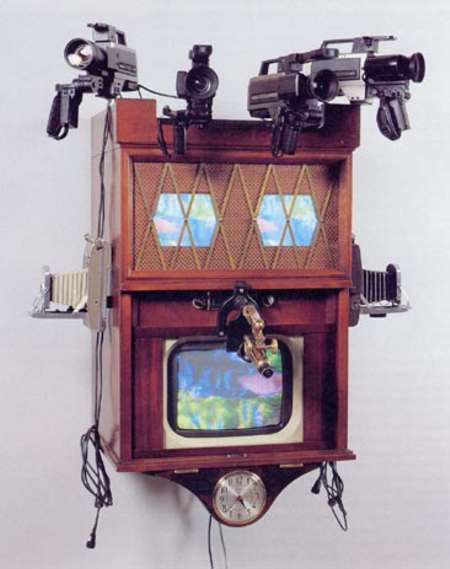
photo:Roman März, Berlin
Paik, pioneer of video art,
has died in Miami.
[BBCworld news/excerpt]
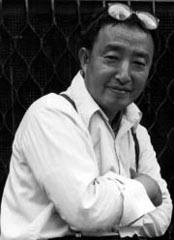
Nam June Paik, the Korean-born artist and composer
regarded as the
inventor of video art, died Sunday of natural causes at
his Miami
home. He was 74.
Paik is thought to have coined the terms
"information superhighway"
and "the future is now," as well as having
global influence with his
work.
Paik's art combined the use of music, video images and
sculptures in
a way that set the style for future video artists.
"Paik's work would have a profound and sustained
impact on the media
culture of the late 20th century; his remarkable career
witnessed and influenced the redefinition of broadcast
television and transformation of video into an artist's
medium," John Hanhardt, media arts curator at New
York's Guggenheim Museum of Art, said in a statement.
"Through a vast array of installations, videotapes,
global television productions, films, and performances,
Paik has reshaped our perceptions of the temporal image
in contemporary art," Hanhardt added.
http://www.cbc.ca/story/arts/national/2006/01/30/paik-obit.html
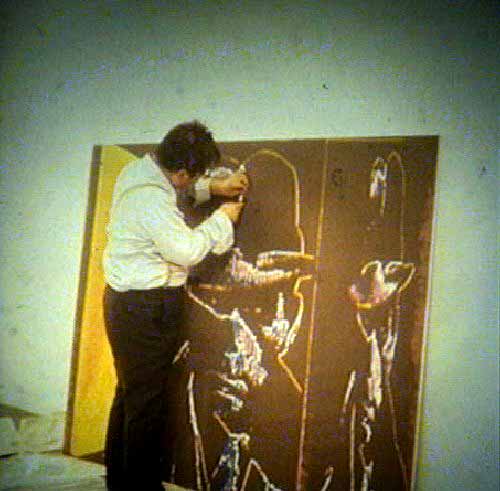
Nam June Paik, the artist, is famous for using
non-traditional materials like a player piano and 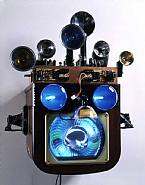 television monitors in his
sculpture. He made Piano Piece to honor his
friend, John Cage, who had died the previous year, 1992.
Some of the videos show images of Paik’s hands and
head, some show images of Cage, and some show other
seemingly unrelated images, like babies. The player piano
plays John Cage’s music all by itself! There is also
a surveillance camera that shows the piano playing as you
watch. If you put your hand on the keys, the camera would
video your hands, which you would see on six of the
televisions.
television monitors in his
sculpture. He made Piano Piece to honor his
friend, John Cage, who had died the previous year, 1992.
Some of the videos show images of Paik’s hands and
head, some show images of Cage, and some show other
seemingly unrelated images, like babies. The player piano
plays John Cage’s music all by itself! There is also
a surveillance camera that shows the piano playing as you
watch. If you put your hand on the keys, the camera would
video your hands, which you would see on six of the
televisions.
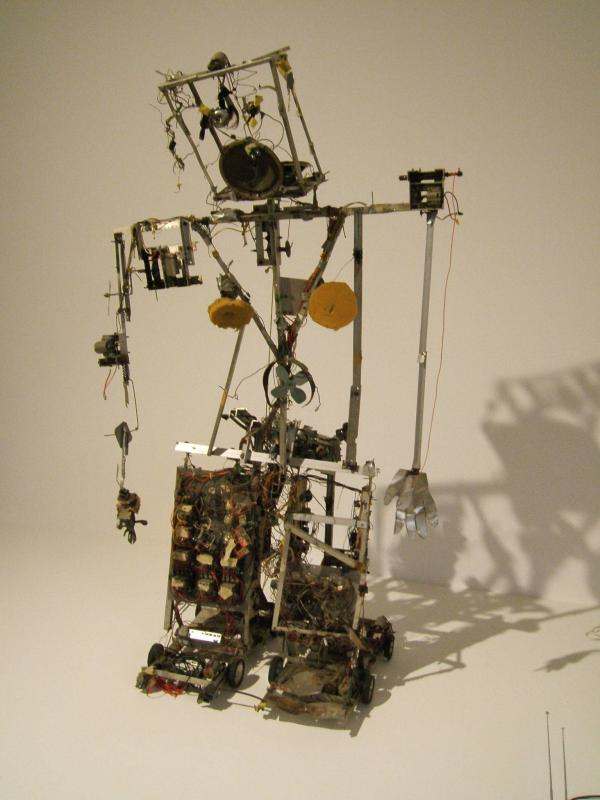
photo Tyler Merkel
By John Hanhardt, Guggenheim Museum
The Worlds of Nam
June Paik is an appreciation of and reflection on the
life and art of Nam June Paik. Paik's journey as an
artist has been truly global, and his impact on the art
of video and television has been profound.To foreground
the creative process that is distinctive to Paik's
artwork, it is necessary to sort through his mercurial
movements, from Asia through Europe to the United States,
and examine his shifting interests and the ways that
individual artworks changed accordingly. It is my
argument that Paik's prolific and complex career can be
read as a process grounded in his early interests in
composition and performance. These would strongly shape
his ideas for mediabased art at a time when the
electronic moving image and media technologies were
increasingly present in our daily lives. In turn, Paik's
work would have a profound and sustained impact on the
media culture of the late twentieth century; his
remarkable career witnessed and influenced the
redefinition of broadcast television and transformation
of video into an artist's medium.
In 1982, my longtime
fascination with Paik's work resulted in a retrospective
exhibition that I organized for the Whitney Museum of
American Art in NewYork.1 Over the ensuing years, his
success and renown have grown steadily.The wide presence
of the media arts in contemporary culture is in no small
measure due to the power of Paik's art and ideas.Through
television projects, installations, performances,
collaborations, development of new artists' tools,
writing, and teaching, he has contributed to the creation
of a media culture that has expanded the definitions and
languages of art making. Paik's life in art grew out of
the politics and anti-art movements of the 1950s, 1960s,
and 1970s. During this time of societal and cultural
change, he pursued a determined quest to combine the
expressive capacity and conceptual power of performance
with the new technological possibilities associated with
the moving image. I will argue that Paik realized the
ambition of the cinematic imaginary in avant-garde and
independent film by treating film and video as flexible
and dynamic multitextual art forms. Using television, as
well as the modalities of singlechannel videotape and
sculptural/installation formats, he imbued the electronic
moving image with new meanings. Paik's investigations
into video and television and his key role in
transforming the electronic moving image into an artist's
medium are part of the history of the media arts. As we
look back at the twentieth century, the concept of the
moving image, as it has been employed to express
representational and abstract imagery through recorded
and virtual technologies, constitutes a powerful
discourse maintained across different media.The concept
of the moving, temporal image is a key modality through
which artists have articulated new strategies and forms
of image making; to understand them, we need to fashion
historiographic models and theoretical interpretations
that locate the moving image as central in our visual
culture.
Paik's latest
creative deployment of new media is through laser
technology. He has called his most recent installation a
"post-video project," which continues the
articulation of the kinetic image through the use of
laser energy projected onto scrims, cascading water, and
smoke-filled sculptures. At the beginning of the
twenty-first century, Paik's work shows us that the
cinema and video are fusing with electronic and digital
media into new image technologies and forms of
expression. The end of video and television as we know
them signals a transformation of our visual culture.
Catelogue & Museum exhibition:
The first chapter of
this catalogue, "The Seoul of Fluxus,"3 is a
consideration of Paik's position as a Korean-born artist
whose interest in art began with composition and
performance. "The Cinematic Avant-Garde," a
survey of independent film practices in the 1960s and
1970s, is offered as a backdrop to his engagement with
various artistic milieus in NewYork and his preliminary
explorations of the electronic moving image, through
video, in the mid-1960s. Performance and film are
integrally linked to Paik's transformation of the
institutional context of television and video.
"TheTriumph of Nam June Paik" documents and
reflects on his heroic effort to support and articulate
the expressive and compositional capacities of the
electronic moving image. Paik put the video image into a
vast array of formal configurations, and thus added an
entirely new dimension to the form of sculpture and the
parameters of installation art. He transformed the very
instrumentality of the video medium through a process
that expressed his deep insights into electronic
technology and his understanding of how to reconceive
television, to "turn it inside out" and render
something entirely new. Paik's imagery has not been
predetermined or limited by the technologies of video or
the system of television. Rather, he altered the
materiality and composition of the electronic image and
its placement within a space and on television and, in
the process, defined a new form of creative expression.
Paik's understanding of the power of the moving image
began as an intuitive perception of an emerging
technology, which he seized upon and transformed. In
addition to collaborating with a number of technicians
such as Shuya Abe, Norman Ballard, and Horst Bauman to
make new tools to rework the electronic image, Paik also
incorporated sophisticated computer and digital
technologies into his art to continue to refashion its
content, visual vocabulary, and plastic forms.
This catalogue offers
a set of exploratory observations. By clustering Paik's
seminal artworks around key concepts and issues that
define Paik's career and achievements, I hope to suggest
the depth and complexity of his aesthetic project as he
has sustained it.4 In addition, I have placed selections
of Paik's writings throughout the catalogue to help
illustrate these observations. The design of the
catalogue, by J. Abbott Miller, offers a fresh view of
Paik's art and career, much as the design of the
exhibition within Frank Lloyd Wright's Modernist
container sets new terms for looking at and engaging in
the full range of Paik's art.Two site-specific
laser-projection pieces dramatically transform the
Guggenheim's rotunda: one laser projects a constantly
moving display of shapes and forms onto the oculus of the
skylight, while a second laser moves through a cascade of
water falling from the top ramp to the rotunda floor,
creating a dynamic visual display through the drops of
falling water.These arresting laser installations can be
viewed from multiple perspectives as the spectator walks
along the ramp.The projections give expression to the
dynamic dialogue between art and technology that is at
the heart of Paik's contribution to art and culture.
On the rotunda floor,
the artist has arranged one hundred television sets and
monitors to distribute a pulsing display of his video
imagery on multiple channels. Complementing these
changing images are large screens installed on the sides
of the rotunda, which visually link the monitors' glowing
images on the ground floor to the laser projections on
the oculus.
Along the ramps of
the rotunda are Paik's seminal video installations
including the large-scale pieces TV Garden (1974), Moon
Is the Oldest TV (1965), and Video Fish (1975), which
have been reconfigured by Paik to suit the unique
exhibition spaces they occupy. Smaller-scale video
sculptures are also installed on the ramps, including TV
Chair (1968), Real Fish/Live Fish (1982), Video Buddha
(1976), Swiss Clock (1988), Candle TV (1975), TV Crown
(1965), and selections from Family of Robot (1986). One
tower gallery will highlig tpieces from the 1950s and
1960s, which have been rediscovered and restored; early
interactive video pieces including Magnet TV (1965),
Participation TV (1963), and Footswitch TV (1988),
accompanied by videotape and photographic documentation
of original installations of this work; the Paik-Abe
Video Synthesizer (1969) and documentation of video
productions made with this early image processor; Fluxus
objects, scores, posters, and videotape documentation of
Fluxus performances that highlight this important aspect
of Paik's career; and a tribute to Charlotte Moorman with
her TV Cello (1971), as well as photographic and
videotape documentation of her legendary performances.
Adjacent to this
gallery is a single-channel screening room featuring
Paik's videotapes and key collaborative works for global
broadcast television, including the recently restored
9/23/69 Experiment with DavidAtwood (1969), Global Groove
(1973), Good Morning, Mr. Orwell (1984), and Living with
the Living Theatre (1989). In preparation for the
exhibition, Stephen Vitiello of Electronic Arts Intermix
was given access to the artist's personal video archive.
In collaboration with Vidipax, Vitiello was able to
restore a number of video and audiotapes which, until
this exhibition, had been lost to public awareness. The
High Gallery will feature Paik's latest laser sculptures
developed in collaboration with Norman Ballard. Each of
the three sculptures features a distinctive deployment of
laser to evoke virtual spaces of moving light.
As the frontispiece
for this introduction, I have chosen to reproduce a work
from 1973 called A New Design for TV Chair. In it, Paik
appropriated an image from a 1940s popular-science
magazine that depicts the home viewer of the future
watching television. Television had already become a
monopolistic industry that was a conduit for advertising,
a "communication" industry that operated on a
one-way street of information. But in A New Design for TV
Chair, Paik posited his own questions to project an
alternative future for television:
DO YOU KNOW...?
How soonTV-chair will
be available in most museums? How soon artists will have
their ownTV channels? How soon wall-to-wallTV for video
art will be installed in most homes?
Paik envisioned a different television, a "global
groove" of artists' expressions seen as part of an
"electronic superhighway" that would be open
and free to everyone.The multiple forms of video that
Paik developed can be interpreted as an expression of an
open medium able to flourish and grow through the
imagination and participation of communities and
individuals from around the world. Paik, along with many
artists working as individuals and within collectives
through the 1960s 14 and 1970s to create work for
television as well as for alternative spaces, challenged
the idea of television as a medium and domain exclusively
controlled by a monopoly of broadcasters.
This introduction concludes with a photograph documenting
Paik's Robot K-456 (1964) in an "accident"
staged in front of the Whitney Museum of American Art in
1982. Paik removed his remote-controlled robot from his
retrospective exhibition at the Whitney and guided it up
the sidewalk along Madison Avenue. As the robot crossed
the avenue, it was struck by a car and fell to the
ground. Paik declared this to represent a
"catastrophe of technology in the twentieth
century," stating that the lesson to be gained from
these tentative technological steps is that "we are
learning to cope with it." Paik's staged event drew
attention to the fragility of humankind and of technology
itself.Twenty years after his first experiments with the
television set, this street performance was made for
television: after the performance, he was interviewed by
television news reports; Paik took this playful moment as
an opportunity to recall the need to understand
technology and make sure that it does not control us.
Paik's staged event with his manmade robot was a humanist
expression of a technology that subverted the dominant
postinstitutions. Paik, who remade the television into an
artist's instrument, reminded us that we must recall the
avant-garde movements of the 1960s and learn from their
conceptual foundation, which expressed. the need to
create alternative forms of expression out of the very
technologies that impact our lives. Robot K-456 is a
statement of liberation, demonstrating that the potential
for innovation and new possibilities must not be lost,
but must be continually reimagined and remade by the
artist. It is my wish that The Worlds of Nam June Paik
will offer a new look at Paik's career and inspire a new
generation of artists to recognize his relevance to
late-twentieth-century art and his impact on the future
of an expanding media culture.5 His everchanging images
offer themselves as the fleeting memories of history and
as an empowering example of the struggle to proclaim the
liberating and renewing possibilities of the future.
Video art imitates nature, not in its appearance or mass, but in its intimate "time-structure" . . . which is the process of AGING (a certain kind of irreversibility). Norbert Wiener, in his design of the Radar system (a micro two-way enveloping-time analysis), did the most profound thinking about Newtonian Time (reversible) and BergsonianTime (irreversible). Edmund Husserl, in his lecture on "The Phenomenology of Inner Time-consciousness" (1928), quotes St. Augustine (the best aesthetician of music in the Medieval age) who said "What is TIME?? If no one asks me, I know ... if some one asks me, 'I know not.' "This paradox in a twentieth-century modulation connects us to the Sartrian paradox "I am always not what I am and I am always what I am not."6 -Paik, 1976
http://www.paikstudios.com/essay.html
HAD A HARD WEEKEND ?
NEED A CURE ?
WELL, HERE'S JUST WHAT YOU NEED............
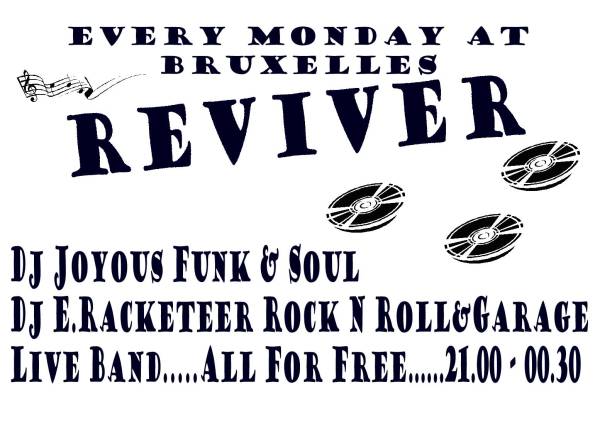
LIVE MUSIC THIS MONDAY FROM
THE PRESCRIPTIONS